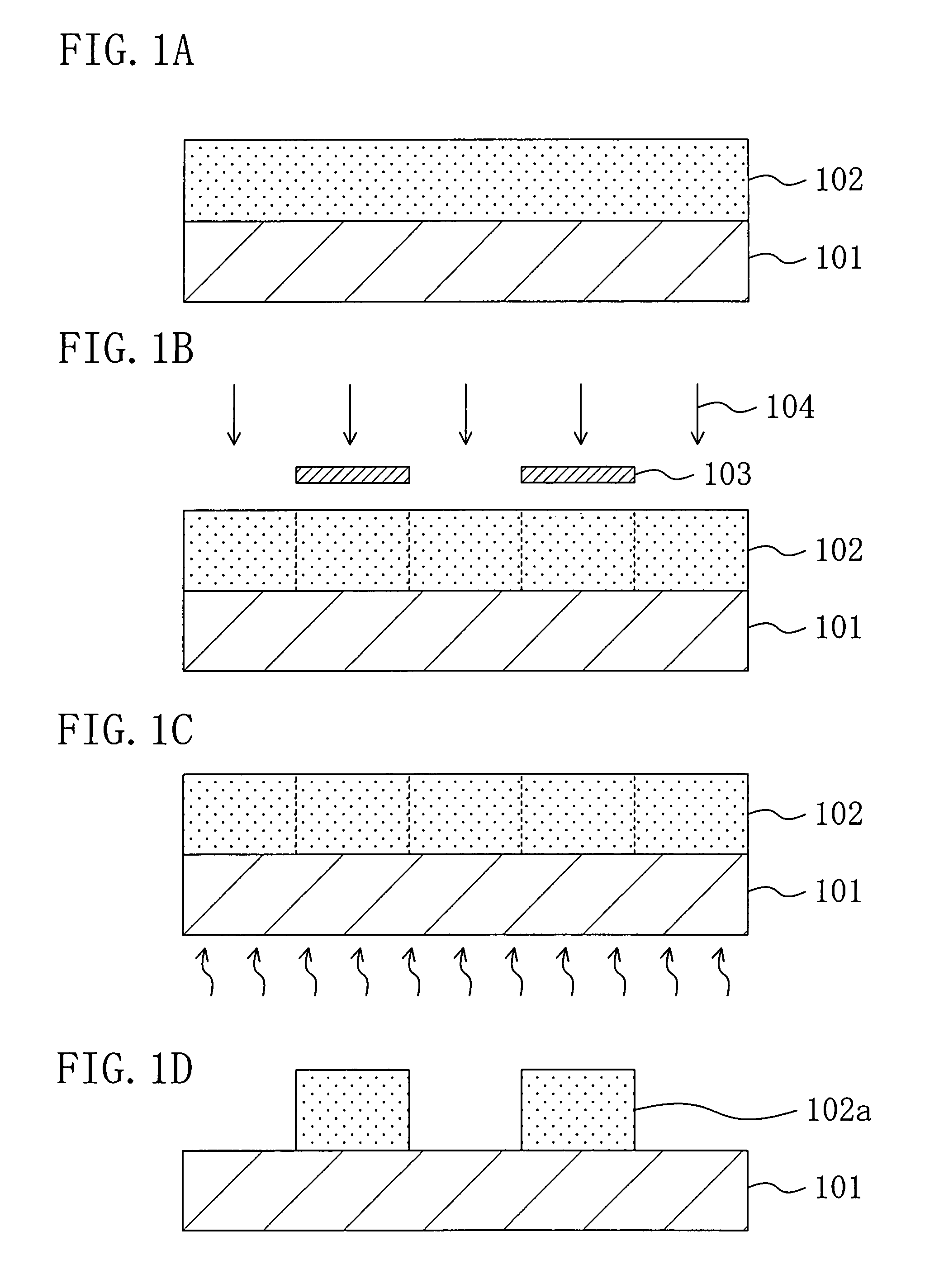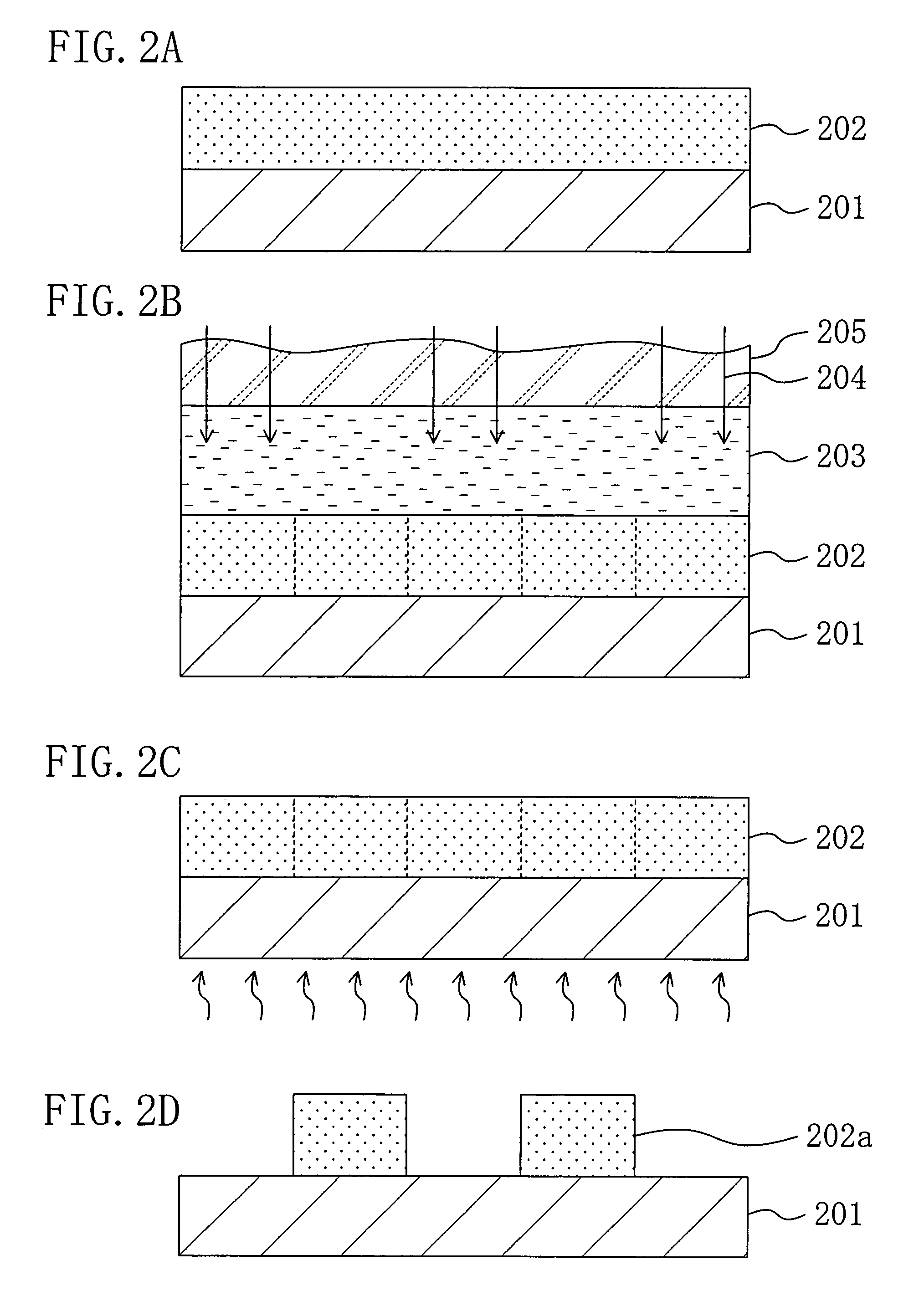Resist material and pattern formation method using the same
a technology of resist material and pattern, applied in the direction of photosensitive materials, instruments, photomechanical equipment, etc., can solve the problems of reducing the productivity and yield in the fabrication process of semiconductor devices, degrading the shape, etc., and achieve the effects of increasing dissolution contrast, and suppressing surface roughness and pattern roughness
- Summary
- Abstract
- Description
- Claims
- Application Information
AI Technical Summary
Benefits of technology
Problems solved by technology
Method used
Image
Examples
embodiment 1
[0042]A pattern formation method according to Embodiment 1 of the invention will now be described with reference to FIGS. 1A through 1D.
[0043]First, a positive chemically amplified resist material having the following composition is prepared:
[0044]Base polymer: poly(vinyl di(adamantoxymethylsulfonamide) (30 mol %)-vinyl sulfonamide (70 mol %)) . . . 2 g.
[0045]Acid generator: triphenylsulfonium trifluoromethane sulfonate . . . 0.06 g.
[0046]Quencher: triethanolamine . . . 0.002 g.
[0047]Solvent: propylene glycol monomethyl ether acetate . . . 20 g
[0048]Next, as shown in FIG. 1A, the chemically amplified resist material is applied on a substrate 101, so as to form a resist film 102 with a thickness of 0.35 μm.
[0049]Then, as shown in FIG. 1B, the resist film 102 is subjected to pattern exposure by irradiating with exposing light 104 of ArF excimer laser having NA of 0.85 through a mask 103.
[0050]After the pattern exposure, as shown in FIG. 1C, the resist film 102 is baked by using a hot ...
embodiment 2
[0057]A pattern formation method according to Embodiment 2 of the invention will now be described with reference to FIGS. 2A through 2D.
[0058]First, a positive chemically amplified resist material having the following composition is prepared:
[0059]Base polymer: poly(vinyl di(adamantoxymethylsulfonamide) (30 mol %)-vinyl adamantoxymethylsulfonamide (5 mol %)-vinyl sulfonamide (65 mol %)) . . . 2 g.
[0060]Acid generator: triphenylsulfonium trifluoromethane sulfonate . . . 0.06 g.
[0061]Quencher: triethanolamine . . . 0.002 g.
[0062]Solvent: propylene glycol monomethyl ether acetate . . . 20 g.
[0063]Next, as shown in FIG. 2A, the chemically amplified resist material is applied on a substrate 201, so as to form a resist film 202 with a thickness of 0.35 μm.
[0064]Then, as shown in FIG. 2B, an immersion liquid 203 of water is provided between the resist film 202 and a projection lens 205. Under these conditions, the resist film 202 is subjected to pattern exposure by irradiating with exposin...
PUM
| Property | Measurement | Unit |
|---|---|---|
| carbon number | aaaaa | aaaaa |
| wavelength | aaaaa | aaaaa |
| wavelength | aaaaa | aaaaa |
Abstract
Description
Claims
Application Information
 Login to View More
Login to View More - R&D
- Intellectual Property
- Life Sciences
- Materials
- Tech Scout
- Unparalleled Data Quality
- Higher Quality Content
- 60% Fewer Hallucinations
Browse by: Latest US Patents, China's latest patents, Technical Efficacy Thesaurus, Application Domain, Technology Topic, Popular Technical Reports.
© 2025 PatSnap. All rights reserved.Legal|Privacy policy|Modern Slavery Act Transparency Statement|Sitemap|About US| Contact US: help@patsnap.com



